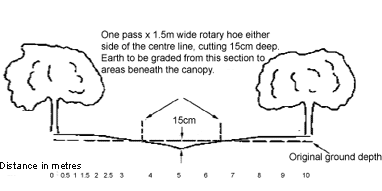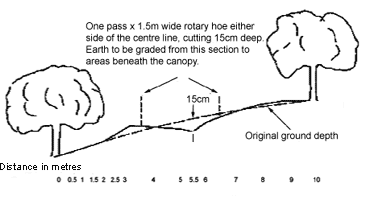
Reducing erosion and other soil degradation in macadamia orchards
Introduction
The macadamia industry has expanded rapidly on the north coast in the last two decades and now occupies over 6000 ha of land in northern NSW. Most of the orchards are growing on krasnozem soil, in high-rainfall areas of over 1400 mm per year.
The area’s high rainfall increases the potential for erosion and nutrient leaching from the soil. Appropriate soil management practices are essential to protect the orchard. Traditionally, a grass sward is left between rows and a bare soil strip has been maintained along the tree row by regular use of herbicides. This practice makes harvesting easier but contributes to soil loss and degradation in many orchards.
Soil issues in macadamia orchards
Soil physical factors
In macadamia orchards, soils are affected by :
- concentrated stemflow (water running down the trunk during heavy rain);
- the impact of raindrops and large water droplets falling through the tree canopy;
- loss of organic matter;
- passage of machinery — particularly when the soil is wet.
These factors:
- erode the soil;
- compact the soil;
- destroy surface soil structure;
- reduce the soil’s ability to absorb rainfall and withstand erosion;
- reduce plant root growth.
Signs of soil erosion are often not as obvious as those for gully erosion. On sloping sites, exposed lateral roots and fine fibrous roots of trees are signs of topsoil loss. Another indicator is erosion along the edge of the bare strip of newly planted orchard rows after prolonged heavy rain. Note that in orchards over 15 years old, exposed roots are common, even on fairly level land.
Soil chemical factors
A major problem in bare soil strips is that soils become more acid . Increased acidity reduces the soil cation exchange capacity, which may lead to deficiencies of calcium and magnesium.
Problems related to acidity appear to be worse on sites previously cultivated for other crops. These areas have already lost topsoil and are chemically depleted before macadamias are planted.
Soil ecological factors
Macadamias probably have an optimum soil environment when decaying plant litter is present under trees. A survey of macadamia roots in a mulch trial conducted by NSW Agriculture found a good association between healthy trees, increased fibrous roots, and mulch in the form of nut husks.
Exposure of bare soil to high summer temperatures can decrease the soil microorganism and earthworm populations that are known soil improvers. Earthworm activity also declines with increasing acidity and declining organic matter. The depletion of soil microorganisms and the decrease in earthworm activity may contribute to soil degradation in macadamia orchards.
Mechanical harvesting
Most macadamia crops are mechanically harvested after removal of the leaf litter from underneath the trees. This process leads to soil loss. Lighter harvest machines are being developed that have a less destructive action on the soil. Further development of harvest machinery aims to recover nuts from light leaf litter and mulch, thus obviating the need for removing all the leaf litter in order to harvest the nuts that have already fallen.
How to reduce soil erosion and other degradation
There are three ways to reduce soil erosion and degradation in macadamia orchards:
- control run-off water
- mulch
- grow groundcovers.
Controlling run-off
Experience shows that the traditional method of planting trees without mounding, combined with bare soil along the tree row, causes erosion problems , even on relatively flat land. Water runs down the tree trunk and along the tree row, removing soil and exposing tree roots. As soil is removed, the tree row acts more and more as a drainage channel, increasing the rate of erosion.
To control erosion in macadamia orchards, run-off must be controlled. The run-off problem is aggravated in mature orchards where larger trees increasingly restrict the growth of groundcover by shading . This bare soil becomes more susceptible to erosion. Intense run-off also carries away fallen nuts before they can be harvested, and some growers have recorded losses of 2–3 kg of nuts per tree.
Much of the land on which macadamias are grown in northern NSW is unsuitable for the traditional run-off control measures of contour or diversion banks . Contour banks do not work in high-rainfall areas because they can be breached by heavy falls of rain. They can also pond water, which is not desirable. Contour banks make it difficult, if not impossible, to carry out routine mechanical harvesting because working across the slope is dangerous.
The run-off control system that is easiest to build, and works most efficiently, is to run mounded tree rows and associated drains directly downhill . An essential proviso is good groundcover in the interrows and drains. As the profile across the interrow area is not pronounced, cultural operations with machinery are not affected.
The other important component of run-off control is the retention of grassed watercourses of sufficient capacity . Trees should not be planted in or immediately next to these. Run-off from the rest of the orchard can then be directed into these watercourses.
In established orchards, trees already planted in natural watercourses and acting as erosion points where soil is bare should be removed and the watercourse grassed . The best time to do this work is September–October after harvest, when kikuyu or other preferred species are about to resume growth, and the risk of heavy, erosive rainfall is lower than at other times of the year. Suitable low-growing legumes or grasses adapted to shade can also be planted.
Building mounded rows to control run-off before planting
The best time to build mounded rows is before the orchard is planted. It is easier and less expensive, and the drainage network can be planned and properly located. Also, permanent groundcovers adapted to low light are easier to establish over the entire orchard floor.
If you have not yet planted your orchard and have decided to build mounded rows, use the following technique:
- When making rip lines for planting, do not make them continuous. Leave a 2 m gap every 15–20 m. This will help prevent erosion along the rip line.
- Then excavate the cultivated soil in the centre of the interrow area to a depth of 15 cm and place this soil in the proposed tree row, making a mound 30 cm above the low point in the middle of the interrow.
- Sow the whole area immediately to an annual covercrop (such as ryegrass, which establishes quickly) or with species that will provide a permanent grass–legume sward. Only the spot where you are actually going to plant each tree should be left clear of vegetation. If this area has revegetated before you plant your trees, spray the planting sites (0.5–1 m diameter) with herbicide.
Rows running directly downhill allow for low-profile, mounded tree rows, interrow drainage, and management of the orchard.
Building mounded rows in an established orchard
Mounds can also be built in established orchards, although it is more involved. The technique favoured at present is as follows:
- Where rows are 9–10 m apart, rotary hoe to a depth of 15 cm on either side of the centre of the interrow area, giving a cultivated strip about 3 m wide. The rotary hoe loosens soil for excavation and chops up the kikuyu, or other stoloniferous groundcover, into a mass of short stolons that can be used to revegetate the area. Where there is no groundcover present on the orchard floor, or existing groundcover is sprayed with herbicide because it is not wanted, a light ripper can be used in place of the rotary hoe.
- Make two passes with a road grader either side of the centre of the interrow area to excavate a broad, shallow, V-shaped drain. Use the excavated soil to make a low-profile mound along the adjoining tree rows (see Figure 1 and Figure 2).
- Rounding off the mound around the trees requires smaller machinery to negotiate the under-canopy area. It is a good idea to take this opportunity to apply aglime or dolomite, zinc and copper to the cultivated soil before grading, if required.
- If you are going to keep kikuyu (or other stoloniferous species) as a vegetative cover, spread the chopped stolons over the excavated area to speed up the regrowth.
- Hedging, and skirting of the lower branches on trees older than 7 years, makes it easier for the grader to construct the low-profile mounds.


Mulching
The practice of maintaining a continuous bare soil strip is undesirable. More growers are now using mulch or groundcover to protect the soil, especially in young orchards. The general practice is to let interrow swards bulk up before slashing and then to direct slashed material into the tree row. In older bearing orchards it is now common practice to mulch leaf litter and tree prunings in place each year before harvest commences.
Trial results indicate that mulching can improve yield and tree health . Another benefit of mulching is that herbicide usage is reduced by extending the interval needed between sprayings, or is virtually eliminated.
Barner grass, macadamia husks, fowl manure and bagasse mulch were compared in a demonstration trial under 10-year-old trees with macadamia decline symptoms. It showed that the application of macadamia husks resulted in the best response in the trees , with increased root growth and improved tree health. See Agfact H3.3.3 Macadamia decline.
Growing groundcovers
Low-growing perennial groundcovers stabilise the orchard floor and reduce soil erosion. Trial results indicate that growing groundcover is the most effective means of reducing run-off and erosion in mature orchards. Nutrient losses in run-off water are also reduced. Sweet smothergrass (Dactyloctenium australe) has been identified in trials for its ability to grow well in shade in mature orchards (see Agnote DPI-382 Sweet smothergrass — a perennial groundcover for subtropical orchards).
Amarillo peanut is not as shade-tolerant as smothergrass, but is a useful legume in the area between tree rows, rather than along tree rows (see Agnote DPI-332 Amarillo peanut — a perennial groundcover for subtropical orchards).
Care should be taken to keep groundcovers short in the harvest season to assist mechanical harvesting of nuts.
Further information
Scientific books and papers
Firth, DJ, Loebel, MR and Johns, GG 1994, ‘Effect of Ca, Mg and mulch on growth, yield and “decline” of macadamia’, Tropical Agriculture 71, 170–5.
Firth, DJ, McFadyen, LM & Morris, R 2002, ‘Groundcovers for macadamia orchards: stage 2, evaluation of best selections and screening of new species’, Final Report to Horticulture Australia Limited for project MC 98031, NSW Agriculture, Alstonville.
Reid, G 2002, ‘Soil and nutrient loss in macadamia lands: a pilot study’, Final Report to Horticulture Australia Limited, NSW Agriculture, Wollongbar.
Soil Sense — Soil management for NSW North Coast farmers 2000 (second edition). Compiled and edited by Rebecca Lines-Kelly.
Agfacts
Macadamia decline (H3.3.3)
Mulching tree and vine fruits on the North Coast (H1.3.8)
Covercrops for subtropical orchards (H6.3.10)
Agnotes
Amarillo peanut: a perennial groundcover for subtropical orchards (DPI-332)
Sweet smothergrass — a perennial groundcover for subtropical orchards (DPI-382)
Author: Daryl Firth

